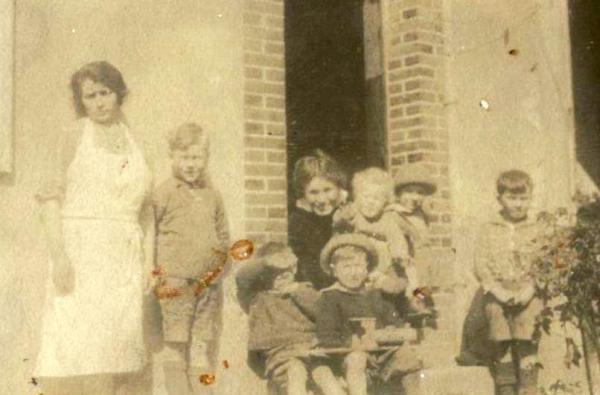Arriving in Paris before dawn on July 26, 1926, Carl Schmitt, as many artists before and since, was exuberant. “Paris is a wonderful city,” he wrote his brother Robert that same day. “The gardens and even forests within the city are astoundingly beautiful when first seen (and after).” He was staying at the Hotel St. James on the Rue de Rivoli, in the heart of the historic city. “My balcony overlooks the Tuileries gardens with the Orleans station directly opposite; across the Seine and to the left stretches the great mass of the Louvre.” His first day in Paris was taken up with exploring the great museum and its artistic treasures. “I looked at every picture there the other day and enjoyed the thousands of Americans doing the same.”

Schmitt’s snapshot of the interior of Chartres cathedral.
“The soul should be like a perfectly transparent window,” he wrote in his studio notebook in December, 1928, “But the imagination should be like the lancet over the altar at Chartres.”
Schmitt had dreamed of settling in Europe since his first trip there in 1914. He was particularly drawn to Dalmatia and the Adriatic coast, where, as he later related to the Catholic activist and writer Peter Maurin, “people still combine cult, that is to say liturgy, with culture, that is to say literature, with cultivation, that is to say agriculture.”
After leaving the region and before coming to Paris, however, he informed Robert that “Dalmatia would never do for the family.” Schmitt had long venerated Gothic art and architecture, calling the cathedral at Chartres “that marvel of marvels,” its exterior figures and the decorations of its portals “sculpture at its highest.” He went on to say that “France is certainly beautiful and I feel very much at home here, and I am sure it is best for family for a long stay.”
In August, Schmitt secured a house in the town of Chartres, not far from its great cathedral. His wife Gertrude, traveling with their six children, joined him there in early October. Life in the little village surrounding the great church, however, turned out be less than ideal. A letter to his brother shortly after Gertrude’s arrival was sober: “Concerning life here: The disadvantages just about outweigh the advantages. It is about as dark as a winter’s twilight in Silvermine—all day. So painting except in monochrome is out of the question, and as far as ‘art’ is concerned I was much better off in Silvermine.” As was characteristic of him, Schmitt found humor in his unhappy circumstances, noting that the new maid “is practically worthless, but we expect to at least give her a start in the world so she can be equipped for life’s struggle.”
But the condition of his family was far from humorous. “The children have all been sick of fever and bronchitis as well as myself,” he wrote to Robert on New Year’s Eve. “They were all in bed a week and I have just gotten up today for the first time. You can imagine how much work for Gertrude, the maid being worthless practically.” He admitted, reluctantly, that it was best to come home. “I dread the thought of moving again and I dread the thought of staying another day . . . I do not think it will be for long, however, as we expect to come home the last of April.”
A month later things had improved considerably. Schmitt was working hard at a commission and “six small canvasses.” The children, recovered both from their sickness and the local schools, were now taught by a governess “who takes perfect care of them and is very conscientious. Today was another beautiful day—like spring—and we are having our first favorable reaction. The neighbors are pruning their fruit trees and getting gardens ready, and people on the streets are beginning to look cheerful again.”
By this time Schmitt had already booked passage for his family back to America. It would be ten years before Schmitt would again venture to bring his family to Europe. They set out for Italy and lived there for a time, but his dreams of making it their permanent home would be dashed, this time by the onset of World War II. After settling in Silvermine for good, Schmitt never lost his love for Europe, seeing it as “an island of the Fine Arts; the locus of the full liberation of the imagination.”




This is beautiful. Thank you so much.
Thank you! So glad you’re enjoying reading the blog as much as I do writing it. There’s much more to come.
The stay in France makes us see how hard it is to be poor especially in a foreign country. What courage they had and there were four more children when they returned to the U.S.
Pingback: More “lost” paintings—Imaginative works | Carl Schmitt: The Vision of Beauty
Pingback: “Just look at it!”: Immanent Trinity Decoration (1924) – Carl Schmitt: The Vision of Beauty
Pingback: On This Day: March 10, 1926 – Carl Schmitt: The Vision of Beauty
Pingback: “Just look at it!”: Immanent Trinity Decoration (1924) – Carl Schmitt: The Vision of Beauty
Pingback: Impressive Carl Schmitt painting now for sale – Carl Schmitt: The Vision of Beauty
Pingback: “Just look at it!”: Boy with ’Cello (1931) – Carl Schmitt: The Vision of Beauty
Pingback: Carl Schmitt—Catholic Radical – Carl Schmitt: The Vision of Beauty